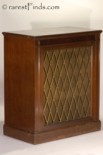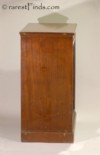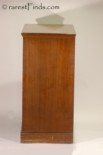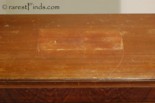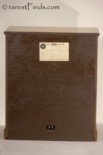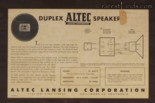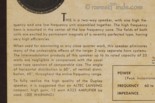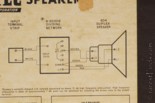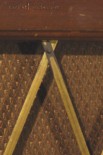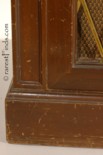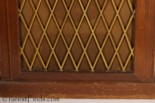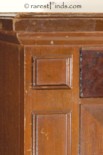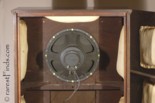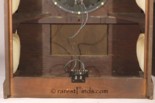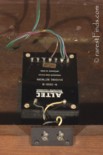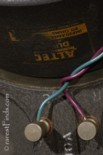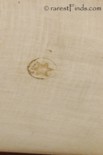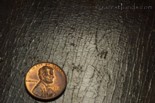Legendary ALTEC LANSING 604 Duplex Speaker With Original ALTEC Residential 605 Enclosure or Cabinet. Price $3,950
You found it; not much needs to be explained! ALTEC (standing for ALl TEChnical), the renowned company which built seminal audio equipment cherished by audio aficionados to this day and this for good reasons. The specifications and sound are unequaled to this day and are second to none.
The ALTEC 604 Duplex is the original first speaker of the very successful line of Coaxial system speakers and highly sought after by collectors. The original 604 Duplex is the only one with an impedance of 20 ohms, see picture 15. The 604B followed with an impedance of 16 ohms.
Any original 604 Duplex is a rare find; to find one in an original ALTEC residential 605 enclosure or cabinet is very difficult, to find two (stereo) at the same time as a pair is close to impossible. (A pair was sold on June 6, 2011 on eBay for $14,100. The cabinet or enclosure was the one which is easier to find.
Back in the forties and early fifties there was only monaural audio; stereo came only on the market in 1958. This is the reason why these early ALTEC speakers, like the seminal and legendary model 604 offered here doe not show up in pairs. when these speakers were sold in small numbers to recording studios as monitors and to wealthy individuals as high-end audio
The ALTEC Duplex model 604 came on the market in 1944.
Somebody out there may have already an original residential 605 enclosure or cabinet like this one and is looking for a second one ..... or, more and more collectors discover the single ended enjoyment of music however. I personally prefer to listen to the best sound reproduced by a monaural system rather than the sound of a lesser quality on a stereo system.
There is another reason why they sound so great. Starting with the availability of studio tape recorders such as the recorders manufactured by AMPEX, music was monitored and mixed based on multiple channel recordings listened to with the 604 Duplex. It was in May of 1953, when AMPEX started production of multi channel tape recorders. The ALTEC Duplex 604 became the standard to be used to mix the different channels in order to create the master from which records were pressed.
What ever sounded best with the 604 speaker as a monitor was mixed that way and masters records pressed accordingly. It was done this way for decades. If you want to hear the record as it is intended to sound, the 604 is the speaker to have.
Back in the forties and early fifties there was only monaural audio; stereo came only on the market in 1958. This is the reason why these early ALTEC speakers, like the seminal and legendary model 604 offered here doe not show up in pairs. when these speakers were sold in small numbers to recording studios as monitors and to wealthy individuals as high-end audio
The ALTEC Duplex model 604 came on the market in 1944.
For more information, click on the picture on the right and download the brochure to read (size
equipment nd
Condition:
This ALTEC 604 Duplex is in fine condition and works as intended. I have only removed dust and have not tried to make it look better with furniture polish or anything else. The cabinet is in "as found" condition. To show the fine crazing of the lacquer I took a picture in bright cross light from a spot light, see picture 18 (last picture).
This cabinet has no issues with the veneer or any other issues. The fabric is all original, the damping pillows inside are all original. There are no repairs of any kind anywhere.
On top is a square of the size 5⅝ by 10 inches which was covered for a long time by something placed there. The wood or finish surrounding the spot became darker over the last 75 years.
Picture 15 shows the decal on the speaker; part of the decal is rubbed off. What is still clearly visible is the writing "DU" from DUPLEX, and "IMPEDANCE 20 OHMS." The model number "604" is rubbed off by the wire over time. There is no question that this is an original 604 and not a 604B as only the 604 had an impedance of 20 ohms, the 604B had an impedance of 16 ohms.
For what ever reason, this enclosure is fitted with the dividing network or crossover N-1600-A instead of the original N-2000-A. The N-2000-A has a crossover frequency of 2,000 Hz, the N-1600-A one of 1,600 Hz. The model following the original 604, the 604B, was using the crossover N-1000-A with the crossover frequency of 1,000 Hz. If you mount the N-1600-A diagonal as it was done in this enclosure, two of the original screw-holes can be used and no new holes are visible other than the four mounting holes for the original N-2000-A crossover.
The Altec 604 Duplex Speaker offered here was in storage for the last 50 years but sounds absolutely amazing. This 604 Duplex still has its original label on the back panel.
History:
The history of the ALTEC 604 Duplex speaker is giving testimony to what it takes to achieve an extraordinary result. What it took is the culmination of many different simultaneous circumstances; a group of genius engineers with all the knowledge and experience in sound reproduction available at the time eager to build the best speaker possible, by applying the knowledge of cutting edge science in the field. The recent discovery of ALNICO 5 permanent magnets was also helping. The group of engineers mast have foreseen the awakening demand for high quality sound equipment. All necessities to create the best speaker possible, the ALTEC 604 Duplex.
The following is an article by John W. Johnson from “The Image of Ling-Temco Voight”, (“LTV”) a publication of the then parent company of Altec Lansing. It is an excellent overview of the history of the company from its founding to the date of writing in December 1963. I allowed myself to add some information.
Dr. Lee De Forest, inventor son of an Iowa minister, experimenting with heated filaments, introduced a grid of fine wire mesh into a vacuum tube and the world of electrically amplified sound was born. The year was 1906. A few years earlier (1894) Thomas Edison had come up with the first motion picture - a peep-show device he called the kinetoscope. These developments, within about 10 years of one another speeded the evolution of two great new industries; radio broadcasting and motion pictures, and led, coincidentally, to the eventual birth of Altec — LTV's California based subsidiary in the audio field.Altec Lansing changed owenership several times and is still in business today manufacturing and selling speakers, headphones.
But before this happy conjunction took place, radio was to become a giant that nearly destroyed its less rapidly developing sibling. While the silent movie industry was perfecting its techniques generating from successes like Ben Hur (1907) , “Quo Vadis” and “Birth of a Nation” (both 1913), radio swept ahead under the impetus of World War I. Within a decade, radio had become a necessity in practically every home. What followed then was to be repeated later with the advent of television – people, in large numbers, quit going to the movies. If the motion picture industry was to survive, it had to bring sound to its silent screens.
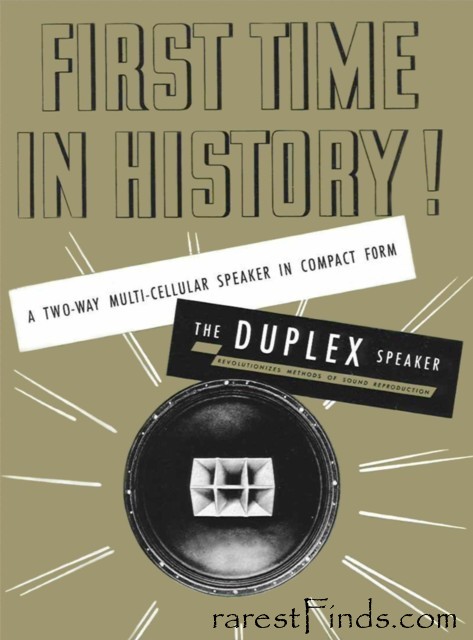
As far back as 1894, Mr. Edison had experimented with synchronizing his phonograph with the kinetoscope. And Dr. De Forest, by 1923, had invented the “phono-film” and made the first public showing of a “talking picture.” These pioneering efforts did much to advance the art but much more was needed. And quickly.
Bell Telephone Labs, deeply immersed in the needed research and development, had progressed far enough to enable Western Electric Co. to make movie sound commercially feasible by the mid 1920's. “Don Juan” a Warner Brothers production, was released in 1926 as the first truly sound picture. It featured a musical score synchronized on a disc. The following year, Warners' came out with “The Jazz Singer” starring Al Jolson and effectively employing spoken dialogue. With the “Jazz Singer,” the talking picture was born. Western Electric Co., seeing a tremendous new market opening up, scouted the country in search of engineers who understood the workings of the vacuum tube.
A young electrical engineer, fresh out of Texas A&M, had gone to work for the Bell Telephone Co. in Houston the year the “Jazz Singer” was produced. Seeing his first sound movie in 1923, he applied for a transfer to Western Electric Co. Co., eager to become a part of this exciting application of the science of sound. His name was Alvis A. Ward, president of Altec. Mr. Ward was one of a group of young engineers, many just out of college, who went with Western Electric Co. to service the needs or the exploding talking picture industry.
In 1930 Western Electric Co. Co. established a division to install and service loudspeakers and electronic products for motion-picture use. Named Electrical Research Products, Inc. and commonly referred to by the acronym ERPI.
Recalling that early period, Mr. Ward said he thinks he installed sound systems in every theatre in East Texas.
The movies, in sound, had found the answer to radio. But they did not find an easy answer to the massive depression that spread over the country in the 1930's. While Eddie Cantor was singing, “Potatoes are cheaper, tomatoes are cheaper, now's the time to fall in love”, former movie patrons couldn't dig up the price of a ticket.
By 1936, Western Electric Co. decided to dissolve its big motion picture service organization ERPI. Rather than see this happen, a group of ambitious young engineers, headed by the late George Carrington, Sr., and L. W. (Mike) Conrow, Alvis Ward, and H.M. Bessey, secretary-treasurer, went into action. They founded Altec Service Company (for “all technical”), more from faith in their own abilities than from the economic facts of the situation, and moved ahead. Predictions were that Altec might last two years.
The fledgling company, composed of most of the country's talking picture experts, began life with ERPI assets purchased from Western Electric Co. for $23,499.66. Altec's greatest asset was its people - 295 of the best trained and most experienced in the audio industry - but it was solely a service company up to this point.
If it was to continue to grow it needed to develop a manufacturing capability. This required facilities. A nearly bankrupt west coast loudspeaker company, Lansing Manufacturing Co., provided the needed opportunity. Lansing was purchased for $50,000 cash in 1941. Altec now had its facility to develop a source of supply for theatre equipment. Alvis Ward came West from New York to manage the new branch of ALTEC, the Altec Lansing Corporation. The quarters at 6900 McKinley in Los Angeles are today remembered as a “hole in the wall.” Packing cases served for office desks. Prospects must have seemed bleak. To better the situation, Altec Lansing Co. later moved to 1161 No Vine Street, Hollywood 38, California.
Only 25 people were on the payroll. Mr. Ward, who had been working in diversification areas with Altec, found real opportunities to diversify with the onset of World War II. Altec Lansing soon was at work for the Navy on magnetic airborne detection equipment. (Much of the work in this period was done in association with GSI, the company from which Texas Instruments was to spring.) With war's end, Altec Lansing continued its steady growth pattern. The “talkies” now long taken for granted, had really represented a tremendous forward step in advancing the technology of electrically amplified sound .They had led to large scale development of public address systems and to a conscientiousness of acoustics that had never existed before.
Accelerated work with vacuum tubes, spearheaded by radio, but also by the demands for better sound systems had opened up an exciting new market in huge auditoriums, churches and other public gathering places. Electronics, virtually unheard of in its modern-day sense when Altec was formed, was making its impact felt in every area of the country. Altec moved quickly to meet the demand for high-quality, life-like sound for which the movies had created the appetite.
In 1944, Altec upgraded the permanent magnet of the 601 speaker with ALNICO 5 and the legendary 604 was born. In 1946, the company acquired Peerless and entered the transformer field. The secret of an amplifier lies largely in its transformer, and Peerless gave Altec the exacting quality it demanded and the market expected.
The period between 1945 and mid-1963 is graphic evidence of the steady Altec growth LTV has come to look for in this important segment of its corporate team. In that period, Altec:
- Began manufacturing audio amplifiers.
- Became the first company to promote and advertise nationally professional sound systems adaptable for use in the home (thus beginning the hi-fi era).
- Introduced Voice of the Theatre speaker systems that have become known through much of the world.
- Introduced the first commercial condenser microphone.
- Entered the microphone field.
- Entered the professional sound field for radio and recording studios.
- Played a leading role in introduction of stereophonic sound into movie theatres.
- Equipped theaters all over the world with Altec Stereophonic sound equipment.
- Entered the high intensity sound measurement field.
- Completed a modern headquarters plant at Anaheim, California, adjacent to Disneyland.
- Organized a national sales force.
- Entered the high intensity sound generation field.
- Developed the first transistorized repeater amplifier and entered the telephone repeater field.
- Introduced the Giant Voice public address system for use in the Civil Defense Warning System.
- Launched a solid state amplifier conversion program.
- Purchased Gonset Division of Young Spring & Wire, thus entering the amateur and two-way radio communication field.
From the initial group of 295 that came out of Western Electric Co. to form Altec, the company has grown to a total of more than 600 today in Altec Lansing, Altec Service and Gonset. Merged in 1960 with Ling Electronics, Inc., parent company of LTV, Altec stands today as a well-balanced company, diversified, but well-established in the general audio field. In the area of quality audience sound it dominates the market.
In reviewing Altec's present position for Image magazine, Mr. Ward said the company's business is basically in seven baskets: Telephone repeaters, commercial sound, hi-fi components, transformers, recording and broadcasting, Altec Service and theatre equipment manufacturing, and two-way radio. “They are seven good baskets,” he said, “representing a nice, even diversification, and all concentrated in a field we know. When the theatre business is down, as it has been until recently, the other baskets provide built in insurance.”
When the theatre business was badly crippled by the onslaught of television, Altec survived the storm by growing in other areas. But rather than abandon the movies altogether, the company used its unique skills and experience to give the industry a badly needed boost through its work in the development of stereophonic sound. The fabulous growth of the telephone market (80 million subscribers by current count) has displaced the motion picture business as Altec's biggest single source of sales. Transistorized telephone repeater sales have jumped phenomenally thus far this year, mostly through a marketing effort directed toward the independent telephone companies. Pointing out that Altec has only an infinitesimal part of this huge market, Mr. Ward is confident of continued growth.
With the purchase of the Gonset Electronics Division of Young Spring and Wire, LTV's Altec subsidiary is now entering the $135,000,000 commercial mobile radio equipment market. Expected to grow to $300,000,000 by 1967, the market is currently dominated by two companies, who have 88 percent of the sales. With two-way radios going into all types of mobile equipment, from laundry trucks to inter-urban passenger vehicles. Alvis Ward feels the prospects for growth are substantial.
Alvis Ward is confident that the communications business will continue to grow at a rapid pace, and that Altec will grow with it.
When the company built its modern headquarters plant in Anaheim, Disneyland was just getting started. The land then cost $10,500 an acre. Today it probably would bring $65,000 an acre. Even Altec's real estate has shown solid growth. Of the original group of men who left Western Electric Co. to form Altec, many are still with the company. In addition to Mr. Ward, the Altec Lansing management group of Western Electric Co. originals, includes Mr. Morris, Andy Fiore, C. R. Rininsland, Ed Seeley, Jack Gregory, Al Davis, Bob Quinn, Martin Bender, Milt Thomas, Ed Lyman , and J. J. McKeon. Altec Service Company men in management who comprised the original group include: R.E. (Red) Pierce, Marty Wolf, Art Rademacher, Merv Scott, Doug McLean, F. B. Mewbom, Ed Lyman and Mac Neumann. “These men are the main force behind Altec's growth and each of them shares equally in our success,” Mr. Ward said.
The Altec Service Company, long wedded to the theatre sound business, diversified itself in recent years in a way that makes the “all technical" connotation of the company name particularly apt. Based in every big city in the nation, Altec Service engineers and technicians provide service for practically every kind of technical apparatus: Ultrasonic cleaners, automatic parking machines, camera equipped safes (that photograph burglars at work) , hospital equipment and a battery of other types of equipment where the user did not have the technical knowledge and resources to install it and keep it operating.
The word “quality” is spoken with a kind of religious fervor at LTV's Altec. So much so, that the company's name has become synonymous with the word. During a recent national television appearance, Shelly Berman was having microphone trouble. He knew how to solve his problem immediately. “Give me my Altec,” he shouted.
Literature:
(Click on any title to see the online version of the book or publication if there is one.)
[1]
FIRST TIME IN HISTORY, A TWO-WAY MULTI CELLULAR SPEAKER IN COMPACT FORM (1944).
[2]
ALNICO 5 Patent issued on September 8, 1942, number 2,295,082 to Gottfried Bruno Jonas
Inventory Number 09223;
Price: $ 3,950.00.
Prices realized in the past:
- I only found one of the same enclosures on the internet, and that sold for $4,000 in 2022, click here to read about it!
